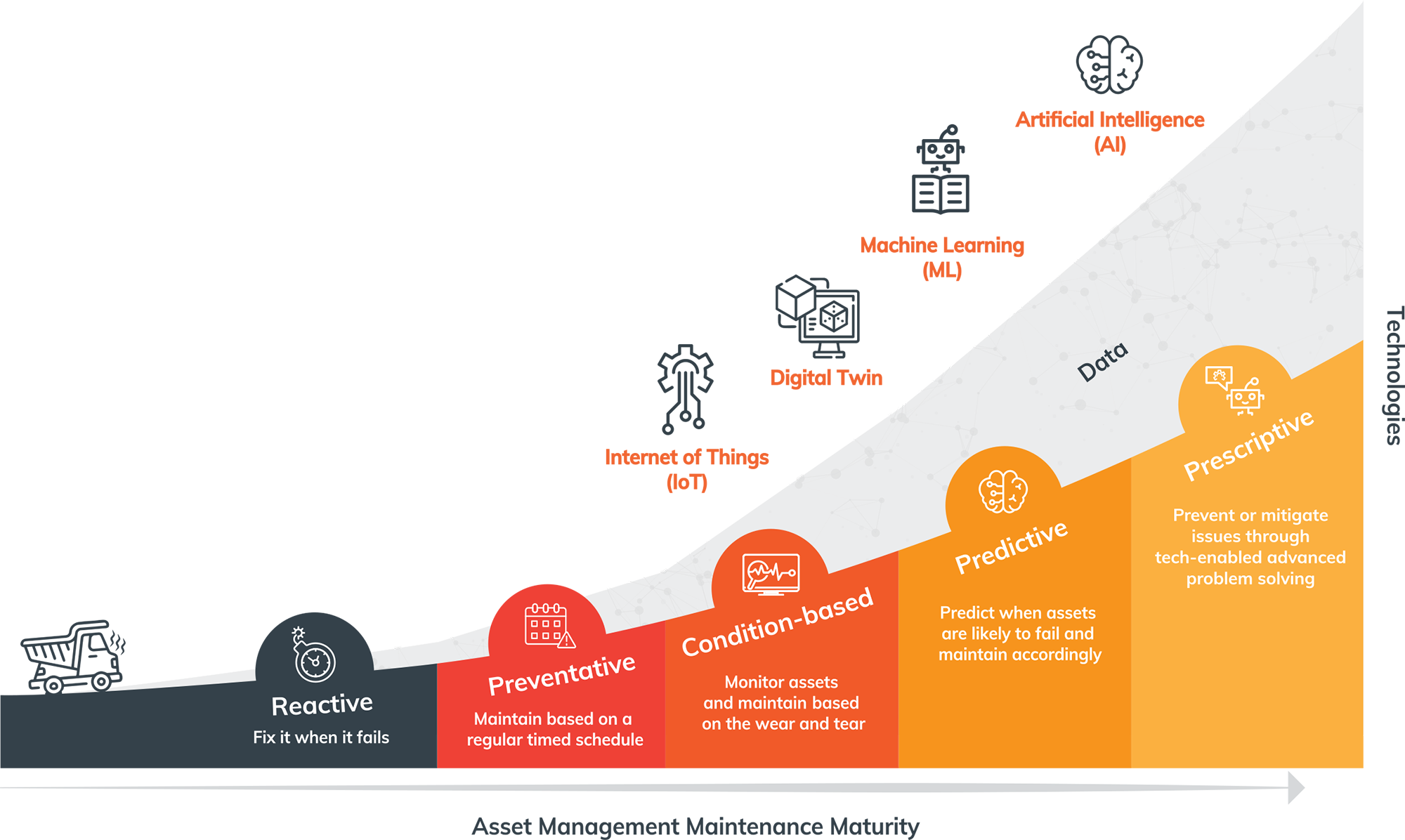At a glance:
- Organisations across sectors are facing unprecedented challenges and pressures forcing them to make significant changes to how they manage their assets.
- The future of asset management will rely on a fully integrated digital asset information ecosystem that combines the right technologies, applications and data to achieve predictive and prescriptive maintenance models that tech-enabled and driven by AI, Internet of Things (IoT), Machine Learning (ML) and data.
- Achieving this level of asset management maturity and leveraging these advanced technologies, tools and automations requires a strong, scalable solution that supports an organisation's current asset management approach and provides a clear path forward to expand their asset management capability.
Organisations across multiple industry sectors especially in mining, utilities and infrastructure are facing unprecedented challenges, but also opportunities.
There are operational challenges such as the soaring cost of unplanned downtime, inefficient run-to-failure asset management practices, reduced workforce retention and productivity, and managing the increasing complex and interconnectedness nature of the data and technologies needed for modern maintenance operations. Then there are external pressures such as decarbonisation targets and sustainability expectations, fixed commodity prices, supply chain and global demand and logistical impacts, and workplace changes with aging workforces and digital native’s workplace expectations.
To survive and remain competitive in their field, asset-intensive organisations need to find ways to better optimise their assets through the application of refined processes and disruptive technology which will drive a reduction of operational costs, increase productivity but also allow them to be more agile and less reactive to various external factors such as sustainability targets and regulatory pressures.
The winners will be those organisations that embrace an integrated approach to enterprise asset management early by establishing strong digital foundations, relevant processes and strategies, adopting advanced technologies and harnessing their vast and increasing amounts of data.
The major challenges for organisations:
-
Soaring costs of unplanned downtime - 50% increase in costs in 2 years1
-
Inefficient run-to-failure asset management practices - 56% of organisations still failure or time-based maintenance2
-
Reduced workforce retention and productivity - 35% of organisations see this as a major concern for the future3
-
Decarbonisation targets and expectations - 88% of organisations see meeting targets as the biggest driver for change4
What does the future of asset management look like?
The future of asset management is set to become increasingly sophisticated and integrated with digital technologies such as AI, IoT, ML, and data visualisation tools to deliver real-time, data-driven insights to organisations about their assets and operations. It will reshape how organisations monitor, maintain, and optimise their assets - making them more resilient, efficient and sustainable. We will see asset intensive organisations use predictive and prescriptive analytics to make tech-enabled and data-driven decisions that will maximise the value of assets throughout the assets' lifecycle (Asset Lifecycle Management).
Recent research by IBM found that this whole of lifecycle approach saw a 47% reduction in unplanned downtime, a 58% faster unplanned downtime resolution, a 17% increase in asset lifespan and a 26% increase in technician productivity5. Additionally, it reduced costs, risks, and waste, while providing improve workplace safety and the ability for organisations to meet ever-changing sustainability goals and ESG compliance.
This ideal asset management approach using predictive and prescriptive maintenance can only be achieved through an integrated asset information ecosystem of data, the right technologies and applications, and supported by expert teams. When working together in real-time, tools and technologies can predict when an asset is likely to fail and prescribe the best and safest approach to solve the issues and avoid the predicted failure. This allows organisations to extract maximum value from each asset, ensure assets are operating at optimum levels to reduce waste (energy, parts, fuel, resources etc), reduce the need to hold excess maintenance items ‘just in case’, and importantly eliminate unplanned downtime.

Above: The asset management maintenance maturity curve and the role technologies and data play in maximising efficiency.
Let's look at the diverse array of applications and data sources available for the future of asset management:
-
Internet of Things (IoT) Sensors: Smart sensors embedded in assets to collect real-time data on performance, condition, and environmental factors. This constant stream of information enables predictive maintenance strategies, allowing organisations to address issues before a costly breakdown.
-
Artificial Intelligence (AI) and Machine Learning (ML): AI algorithms analyse vast amounts of data from multiple sources to identify patterns, predict failures, and optimise maintenance schedules. These technologies enable accurate predictions and provide real-time monitoring for data-driven decisions.
-
Mobile Applications: Field technicians now rely on mobile apps to access asset information, update work orders, and communicate with the central system in real time. This mobility enhances efficiency and ensures that all stakeholders have access to the most up-to-date information.
-
Augmented Reality (AR): AR technology is emerging as a powerful tool for maintenance operations, providing technicians with real-time guidance and support during complex tasks. By overlaying digital information onto the physical world, AR can significantly improve the accuracy, speed and safety of maintenance procedures.
-
Digital Twins: Virtual replicas of physical assets, digital twins are increasingly important in asset management. These digital models simulate various scenarios, allowing organisations to optimise maintenance strategies, improve the safety of maintenance crews, and predict the assets performance under different conditions.
-
ESG and Sustainability: With Environmental, Social, and Governance (ESG) considerations becoming important and expected, organisations are using integrated technologies and data to identify ways to reduce their carbon footprint and improve energy efficiency, and understand how they are tracking towards their ESG requirements and Sustainability goals.
-
Generative AI and Automation: Generative AI is transforming back-office operations, financial reporting, market research, and risk management. Automation of repetitive tasks helps in cost savings and improves the accuracy of financial and operational insights.
- 3D Printing: Additive manufacturing technologies are revolutionising spare parts management, enabling on-demand production of components and reducing inventory costs.
The urgency to establish strong foundations now for the future of asset management
With the proliferation of technologies and data sources, organisations are facing the challenge of integrating disparate systems and data sources today and struggling to identify how to scale their asset management capability to achieve this future state of predictive and prescriptive asset management. The solution to both these challenges is having a strong, scalable and flexible digital infrastructure that will support every stage of your asset management maturity and the technologies it requires.
Central to these strong foundations is the right Enterprise Asset Management solution that provides a central hub for all asset-related information and processes. It must be capable of:
- Integrating data from multiple sources, including IoT sensors, mobile devices, and legacy systems.
- Providing a unified platform for asset tracking, maintenance scheduling, and performance analysis.
- Leveraging AI and machine learning to enable predictive maintenance and optimise asset performance.
- Offering robust reporting and analytics capabilities to support data-driven decision-making.
- Ensuring scalability to accommodate growing asset portfolios and evolving technological landscapes.
As the future of digital asset management continues to evolve, having a flexible, integrated, and powerful EAM solution on scalable foundations will be crucial for organisations looking to optimise their asset performance and maintenance operations. In the second article in this series, we will look at how to establish these strong foundations with EAMaaS and how this provides a clear path forward for asset management maturity.
Discover how an EAMaaS solution can support your asset management maturity goals
SOURCES:
- The True Cost of Downtime, Siemens, 2023
- IDC SaaS Path, IDC, 2023
- Service Leader’s Agenda, Service Council, 2024
- Verdanitix, Global Corporate Survey, 2023
- IBM, Digging Deeper for Sustainable Mining, 2023
- McKinsey & Co, Heavy Industry’s Digital Transformation, 2020


